Scientific name: Malus × ‘Radiant’
Family: Roseaceae
Common name: ‘Radiant’ crabapple
Article by Jeanne Gozigian
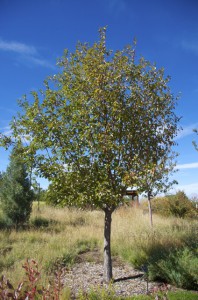
‘Radiant’ crabapple tree in fruit (Janice Tucker)
One of the lovely, spring flowering trees in the Goede Family Orchard at the Botanical Garden at Museum Hill is the ‘Radiant’ crabapple. Its broad, rounded crown sports greenish purple leaves alongside the deep red buds; as the buds open to become single, deep pink blossoms, the leaves turn to green. The magenta hued bark adds more color interest. With maturity, the smallish tree reaches 15 to 25 feet in height and 15 to 20 inches in girth.
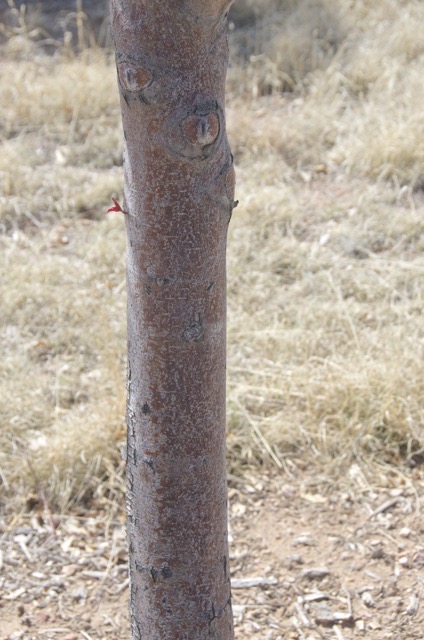
‘Radiant’ crabapple bark (Photo: Janice Tucker)
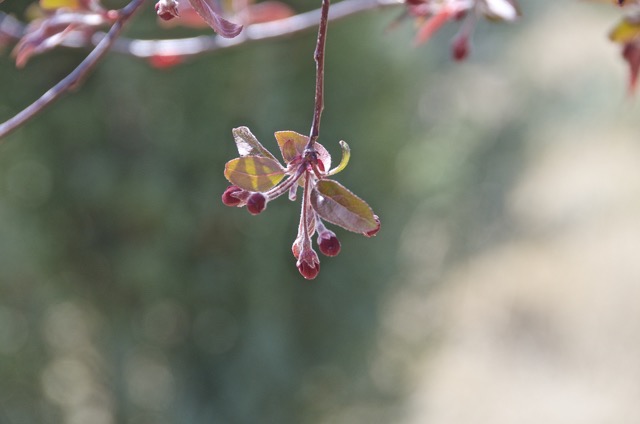
‘Radiant’ crabapple flower bud (Photo: Janice Tucker)
The ripe apples of summer are bright red and ½” in diameter. Fruits larger than 2” are not crabapples but are varieties of Malus domestica*, standard apples. When growing any of the crabapple choices, it is important to prune out the suckers that appear. They may be true apples that want to take over the little crabapple tree. Plant ‘Radiant’ crabapples in full sun, in fertile, well -drained soil. They can be somewhat drought tolerant when established but need enough watering during the growing season to keep the soil moist.
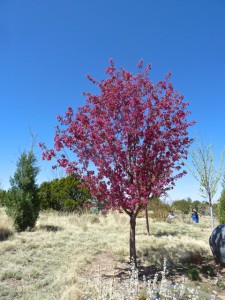
‘Radiant’ crabapple tree in full flower (photo courtesy of Janice Tucker)
These beautiful trees make lovely specimen plantings in lawns and at curbsides and are spectacular in mass planting. However, they do best in mulched areas where they are not surrounded by turf grass, where they might receive too much water and fertilizer. This can lead to susceptibility to diseases such as scab, rust, and powdery mildew. They have a built-in resistance to fire blight. They perform particularly well in the Rocky Mountain states at higher elevations.
Consider planting masses of ‘Radiant’ crabapple for wildlife habitat. Deer, bears, and other animals love to feast on the fallen apples. Birds will feast right from the tree – a problem if you are harvesting the fruit. My mother and father retired to a small dairy farm in the Upstate New York country that had a large, old apple tree in the paddock. One fall day, in a year with a bumper crop of apples, they noticed that their two horses were acting strangely, almost staggering around the paddock. They discovered that the horses were ingesting too many of the fermenting apples and were tipsy!
Crabapples need cold winters to be productive. One wonders what our warming winters will do to fruit tree success. Malus comes from the Greek language, meaning, “melon”. Could that mean that ‘Radiant’ may tolerate warmer temperatures? Here is another example of the magical family of Roseaceae. It gives us beautiful flowers as well as delicious fruit, like apples and raspberries. Crabapples are native to North America, whereas Malus domestica perhaps originated in the Middle East to Central Asia. They can, however, cross pollinate with M. domestica, thus the need to be vigilant in removing suckers and careful orchard planting.
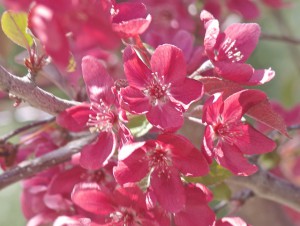
‘Radient’ crabapple flower cluster (Janice Tucker)
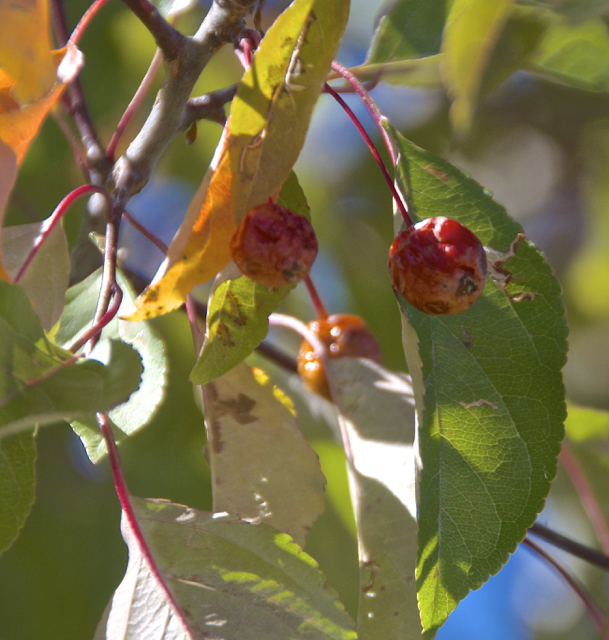
‘Radiant’ crabapple fruit (Photo courtesy of Janice Tucker)
It would be difficult, if not to say impossible, to try to make a pie or cobbler with the ½” ‘Radiant’ crabapples, but one could certainly use them to make a delicious apple butter, so tasty with pork chops or, simply, on a piece of toast. Even easier is to prepare this long-cooking treat in a slow cooker:
Slow Cooker Apple Butter
1 cup packed brown sugar
1 cup honey
¼ cup apple cider
1 Tbsp. ground cinnamon
¼ tsp. ground cloves
1/8 tsp. mace
2 ½ lbs. apples (crabapples), peeled and cut in large chunks
Cook 10 hours in a 5 quart slow cooker on low temperature, until tender. Press through a fine sieve or food mill in batches, discard solids, and return to the slow cooker on high temperature for 1½ hours until thick. Will keep for a week in the refrigerator but could be frozen for long – keeping.
Note: the recipe calls for peeling the apples, but my grandmother always left the peel on when using a food mill to process apple sauce.
*See Janice Tucker’s April 2014, Plant of the Month article: Apple Blossom: Malus domestica.
Many thanks to Janice Tucker, who “stalked” ‘Radiant’ crabapple for me and provided the beautiful photographs.
Sources:
Colorado State University Extension
J. Frank Schmidt and Sons crabapple catalogue
Missouri Botanical Garden
Cooking Light magazine


